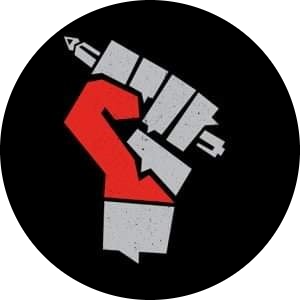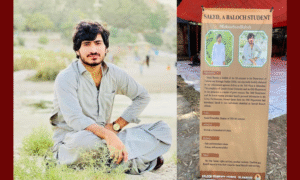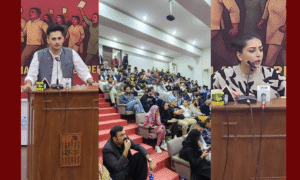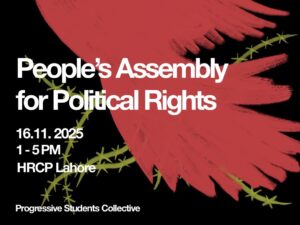In a propitious move, Prime Minister Imran Khan alluded that Student Unions can be revived. Responding to the voice of the youth, manifested in the form of solidarity marches held around the country by Students Prime Minister on 1st December, 2019, just two days after the marches carried out by students on 29th November, 2019, said ‘comprehensive and enforceable code of conduct’ was in place.
There are certain valid questions in the mind of public at large such as what is a student union? , why were they banned in the first place and what the students want now?
Student Union is an institution in which students are democratically elected to represent student concerns and create leadership qualities among the individuals. Student Unions are the nursery of democracy. Serving in the Student Union develops a sense of responsibility among the students helping them in their future. The mandate may vary from varsity to varsity but the main activities revolve around water, transport and quality of food at canteens to scheduling fee at campuses. This training in university assists the students throughout their lives pushes them for sensible and rational decisions.

Student Unions are indispensable to the creation of Pakistan. The Independence movement was prosecuted by Student union activists such as G.M Syed, Abdur Rab Nishtar , Mohammed Ali Johar and many more students that remained unsung. After independence, Pakistan had vibrant politically motivated students forming Democratic Student Federation (DSF), Islami Jamiat e Talba (IJT) and Anjuman Talba e Islam in the 50s.

The 1960s was mostly a quiet era for student unions as people were loosing interest in politics as Ayub’s Martial Law was still in force. The last quarter of the sixties saw students waking up to uphold democratic norms in the country. East and West Pakistan saw the rise of populist parties such as PPP and AML. The creation of Bangladesh was also facilitated by students. Mukti Bahni was also a student organization with the help of India. East Pakistan was separated from its western counterpart. In 1974, Student Union Ordinance that encouraged student political activity on campus was passed by the PPP government. In this period government actually promoted and patronized student politics in universities and colleges. After the coup d’état of General Zia Ul Haq in 1977 and the rise of afghan jihad in 1979 saw the radicalization of students as the policy of state. Militancy was need of the hour then which lead to state sponsored arming of student groups firing deadly conflicts within campuses. These clashes and deaths first caused the state to abolish the student union apparatus in colleges i.e. in 1979. Then, this frustration of having no student leadership fueled the fire of fundamentalism and between 1979 after the ban in colleges till 1983 almost 16 students lost their lives in gun violence. These incidents fostered the complete ban on student unions in the universities and colleges of Pakistan. On 9th February, 1984 through a Martial Law Order (MLO) was passed down by administrators both in Sindh and Punjab. Five years Later after democracy was restored in Pakistan the MLOs were repealed by democratic government in 1989 by the Benazir Lead PPP government. There was a petition 1993 SCMR 1781 filed in Supreme Court where the court verdict forbade student from indulging in politics.

However, directed that “arrangements shall be made as soon as possible and not later than a month to take steps for developing, restoring or re-organizing a healthy student’s discussion and other activity in any form suitable to the individual institutions which might be called by any description; regarding which arrangements for election shall also be made”. The Supreme Court also held that keeping in view the nature of the subject matter will have to be kept under review from time to time by the Supreme Court.
Current stirs about Student unions in Pakistan was brought up the students mainly by those who experienced foreign education and was prone to ideas from books. The Last three, yearly, Student Solidarity March was the reason why the political class and the public at large had to rethink about lifting the ban on Student Unions. Now the time resides with Information Technology and Social Media. Our Elected Representatives have to reassess about how to engage our young, dynamic youngsters. Around 64% of Pakistanis are under 40 years. This youth bulge can be a double edged sword. There is a difference between Student Union and Student Wing (Tanzeem). Union is an elected body of students in a campus that address student issues irrespective of class, religion, caste, race, and ethnicity. Whereas Student Tanzeem is a non-elected body mostly appointed, whether by political parties, ethnic and religious groups. They only represent their group or company.
Conclusion
Student Unions act as an institution throughout the world. These Unions help form collective behavior among the individuals in the campus. They generate their own organizational behavior. There is no ban on student unions as such but it’s the declaration students have to sign before securing admission. Students enrolled in classes of Doctorate and Post-Doctorate should be eligible to run in Presidential elections of the Union. Students in Masters should be allowed to run for general secretary. For Bachelors classes, students should be allowed to run for advisory council seats to the SU President. President of the Student Union must have the right to deploy his administration with the consent of Advisory council.
The Students’ Herald News Desk focuses on reporting the latest news regarding student politics and campus updates to you.
The News Desk can be reached at admin@thestudentsherald.com




